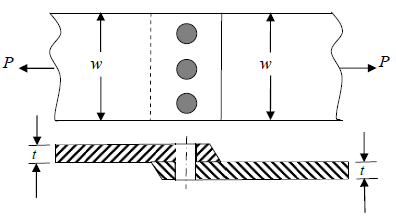GATE 2013 : Mechanical Engineering
 A single riveted lap joint of two similar plates as shown in the figure below has the following geometrical and material details.
A single riveted lap joint of two similar plates as shown in the figure below has the following geometrical and material details.
width of the plate w = 200 mm, thickness of the plate t = 5 mm, number of rivets n = 3, diameter of the rivet dr = 10 mm, diameter of the rivet hole dh = 11 mm, allowable tensile stress of the plate σp = 200 MPa, allowable shear stress of the rivet σs = 100 MPa and allowable bearing stress of the rivet σc = 150 MPa.
Q1. If the rivets are to be designed to avoid crushing failure, the maximum permissible load P in kN is
Options: (A) 7.50 (B) 15.00 (C) 22.50 (D) 30.00
Q2. If the plates are to be designed to avoid tearing failure, the maximum permissible load P in kN is
Options: (A) 83 (B) 125 (C) 167 (D) 501
Ans:











